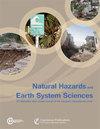季节性后报对创建英国水文干旱故事情节的附加值
IF 4.2
2区 地球科学
Q1 GEOSCIENCES, MULTIDISCIPLINARY
引用次数: 0
摘要
摘要英国过去曾经历过多次水文干旱,包括 2022 年夏季宣布的干旱。由大量可信天气序列样本组成的季节性后报可用于创建干旱故事情节,并为现有的水资源规划方法增添价值。本研究使用 ECMWF SEAS5 后期预报数据集研究了英格兰安格利亚地区冬季降雨的驱动因素,该数据集包括 25 个集合成员和 3 个提前期的 2850 个可信冬季。根据各种大气环流指数(如北大西洋涛动、东大西洋涛动和厄尔尼诺-南方涛动)的可能组合,利用后报冬季定义了四个冬季集群。以 2022 年的干旱为例,我们展示了如何利用代表该事件可能发生的其他方式的故事情节来探讨 2022/23 年冬季及以后可能发生的最坏情况。冬季集群跨越了研究区域的温度和降雨反应范围,代表了 2022/23 年冬季可能发生的环流故事情节。利用大量可信的后预报冬季样本进行的河流流量和地下水位模拟显示,以NAO-/EA-和NAO+/EA-环流模式为主的冬季比平均水平更干燥,可能会导致干旱持续,到2023年春季和夏季,所有选定流域和钻孔的河流流量极有可能低于正常水平或更低。诺福克郡的集水区尤其容易受到 2023 年夏季干旱的影响,因为即使在以 NAO-/EA+ 和 NAO+/EA+ 环流模式为主的湿润冬季,河流流量估计也无法恢复到正常水平,原因是降雨量不足以克服之前的干旱状况,而且以地下水为主的集水区反应缓慢。通过这项分析,我们旨在展示这种方法的附加价值,即在持续事件中创建干旱故事情节。以这种方式构建的故事情节是对传统天气预报和水文展望的补充,以便探索更广泛的合理结果。本文章由计算机程序翻译,如有差异,请以英文原文为准。
Added value of seasonal hindcasts to create UK hydrological drought storylines
Abstract. The UK has experienced recurring periods of hydrological droughts in the past, including the drought declared in summer 2022. Seasonal hindcasts, consisting of a large sample of plausible weather sequences, can be used to create drought storylines and add value to existing approaches to water resources planning. In this study, the drivers of winter rainfall in the Anglian region in England are investigated using the ECMWF SEAS5 hindcast dataset, which includes 2850 plausible winters across 25 ensemble members and 3 lead times. Four winter clusters are defined using the hindcast winters based on possible combinations of various atmospheric circulation indices (such as the North Atlantic Oscillation, NAO; East Atlantic, EA, pattern; and El Niño–Southern Oscillation). Using the 2022 drought as a case study, we demonstrate how storylines representing alternative ways the event could have unfolded can be used to explore plausible worst-case scenarios over winter 2022/23 and beyond. The winter clusters span a range of temperature and rainfall response in the study region and represent circulation storylines that could have happened over winter 2022/23. River flow and groundwater level simulations with the large sample of plausible hindcast winters show that drier-than-average winters characterised by predominantly NAO−/EA− and NAO+/EA− circulation patterns could have resulted in the continuation of the drought with a high likelihood of below-normal to low river flows across all selected catchments and boreholes by spring and summer 2023. Catchments in Norfolk were particularly vulnerable to a dry summer in 2023 as river flows were not estimated to recover to normal levels even with wet winters characterised predominantly by NAO−/EA+ and NAO+/EA+ circulation patterns, due to insufficient rainfall to overcome previous dry conditions and the slow response nature of groundwater-dominated catchments. Through this analysis, we aim to demonstrate the added value of this approach to create drought storylines during an ongoing event. Storylines constructed in this way supplement traditional weather forecasts and hydrological outlooks, in order to explore a wider range of plausible outcomes.
求助全文
通过发布文献求助,成功后即可免费获取论文全文。
去求助
来源期刊
CiteScore
7.60
自引率
6.50%
发文量
192
审稿时长
3.8 months
期刊介绍:
Natural Hazards and Earth System Sciences (NHESS) is an interdisciplinary and international journal dedicated to the public discussion and open-access publication of high-quality studies and original research on natural hazards and their consequences. Embracing a holistic Earth system science approach, NHESS serves a wide and diverse community of research scientists, practitioners, and decision makers concerned with detection of natural hazards, monitoring and modelling, vulnerability and risk assessment, and the design and implementation of mitigation and adaptation strategies, including economical, societal, and educational aspects.

 求助内容:
求助内容: 应助结果提醒方式:
应助结果提醒方式:


